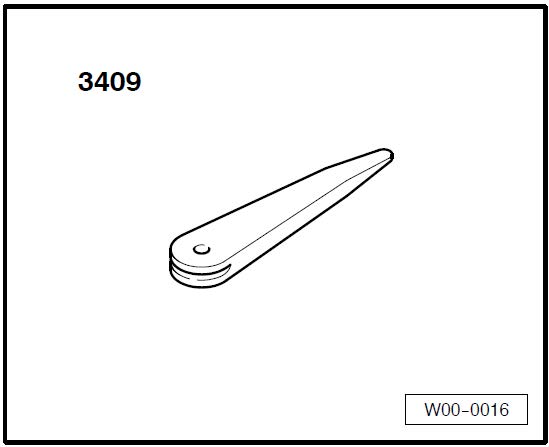| “This site contains affiliate links for which OEMDTC may be compensated” |
April 8, 2016 NHTSA CAMPAIGN NUMBER: 16V200000
Fuel Gauge may Read Higher than Actual
The inaccurate gauge may cause a driver to unexpectedly run out of fuel and the vehicle to stall, increasing the risk of a crash.
NHTSA Campaign Number: 16V200
Manufacturer Bugatti
Components FUEL SYSTEM, GASOLINE
Potential Number of Units Affected 72
Summary
Bugatti is recalling certain model year 2006-2010 Veyron vehicles manufactured March 10, 2006, to January 17, 2010 and 2010-2011 Veyron Grand Sport vehicles manufactured September 29, 2009, to June 30, 2010. In the affected vehicles, the fuel tank gauge may indicate that there is more fuel in the tank than there actually is.
is recalling certain model year 2006-2010 Veyron vehicles manufactured March 10, 2006, to January 17, 2010 and 2010-2011 Veyron Grand Sport vehicles manufactured September 29, 2009, to June 30, 2010. In the affected vehicles, the fuel tank gauge may indicate that there is more fuel in the tank than there actually is.
Remedy
Bugatti will notify owners, and dealers will replace the fuel tank control unit and upgrade the software, free of charge. The recall began on May 23, 2016. Owners may contact Bugatti
will notify owners, and dealers will replace the fuel tank control unit and upgrade the software, free of charge. The recall began on May 23, 2016. Owners may contact Bugatti at 1-805-557-1050.
at 1-805-557-1050.
Notes
Owners may also contact the National Highway Traffic Safety Administration Vehicle Safety Hotline at 1-888-327-4236 (TTY 1-800-424-9153), or go to www.safercar.gov.
Technical Bulletin
16‐04‐013BUG
Tank Control Unit
Applicability:
Bugatti Veyron Bugatti
Veyron Bugatti Grand Sport
Grand Sport
VIN range :
Contact your Bugatti regional service manager
regional service manager
Market Region:
All
Introduction:
Fuel tank control unit requires replacement with later version.
Description:
Fuel tank indicator can show a higher fuel level than the actual level of fuel in the tank.
A new control unit with revised software has been introduced to supply the correct signals from the level sensors.
Warning:
Comply with the vehicle preparation measures for maintenance and repair procedures. Refer to the official Workshop Manual, Page 18 “General instructions about the vehicle”
If in any doubt regarding this procedure, contact your Bugatti regional service manager.
regional service manager.
Procedure:
- Remove centre console armrest (1)
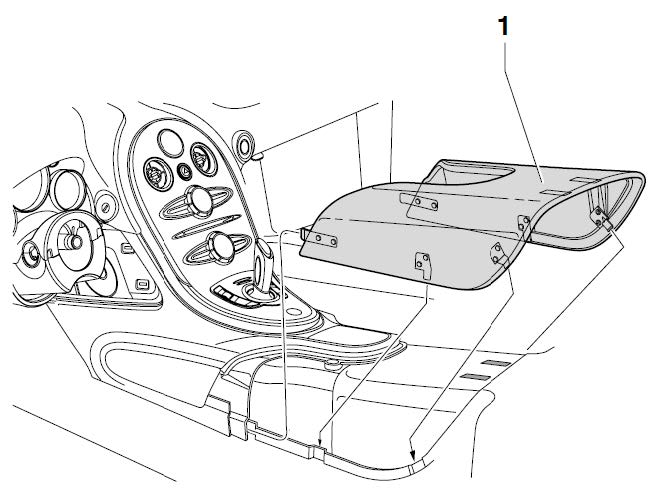
- Remove the passenger side rear wall trim
- Loosen the lower passenger rear wall trim ‐1‐ using a dismounting wedge (e.g. ‐3409‐), in direction of travel ‐arrows‐.
- Pull the lower rear wall trim‐2‐ in direction of travel –arrows to loosen the trim elements.
- Remove the trim ‐1‐ and ‐2‐ upwards in direction of arrow A‐.
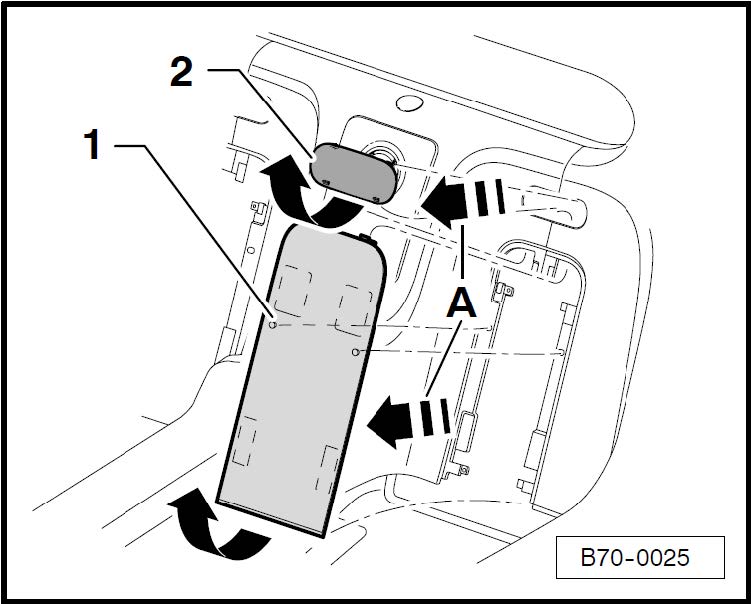
- Remove rear wall compartments (1)
- Open the flap for the tray with the button on the rear wall.
- Unclip the floor compartments ‐2‐ from the tray with a dismounting wedge
- Pull the rear wall compartments ‐1‐ out of the tray.
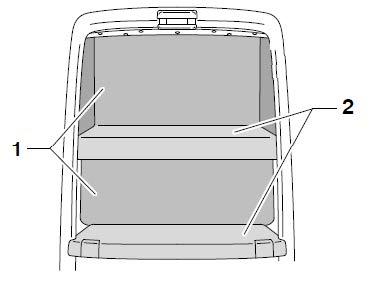
- Centre rear wall trim loosing
- Use a dismounting wedge (e.g. ‐3409‐) to lever out the retaining clips ‐2‐.
- Open the cover ‐4‐ of the tray ‐5‐.
- Unscrew the fastening bolts ‐7‐ and fastening nuts ‐6‐ in the tray ‐5‐.
- Unscrew the fastening bolts ‐3‐ in the centre wall trim
- Unscrew the fastening bolts ‐1‐ in the monocoque
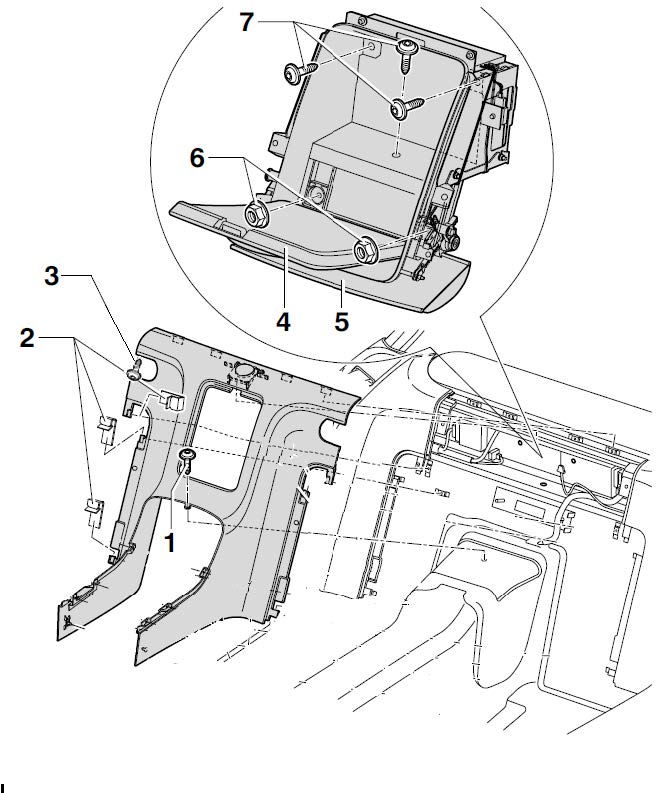
- Gently pull the passenger side of centre rear wall to access the Tank control unit and unplug it.
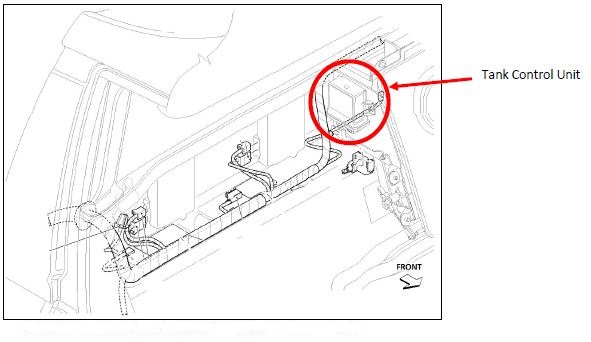
Passenger side view of the monocoque without interior trim
- Unscrew the 2 nuts with 10mm socket
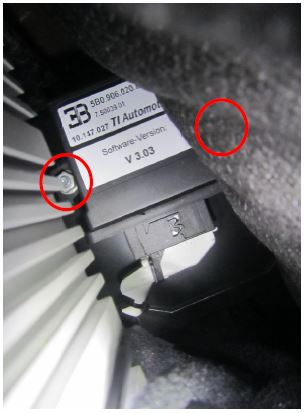
Passenger side view of the Tank Control Unit (while pulling centre rear wall)
- Remove the Tank Control Unit
- Install the new Tank control Unit 5B0906020 B (Software version V 3.03) and screw the 2 nuts carefully (approx. 1Nm)
- Connect the new Tank Control Unit
- Install the centre rear wall trim
Installation is in reverse order of removal.
- Tighten fastening Bolts ‐7‐ to 4,5Nm tightening torque
- Tighten mounting nuts ‐6‐ to 3 Nm tightening torque
- Tighten fastening Bolts ‐1‐ to 1 Nm tightening torque
- Tighten the retaining clips and check for firm seat (All clips must be replaced)
- Tighten fastening Bolts ‐3‐ to 1 Nm tightening torque
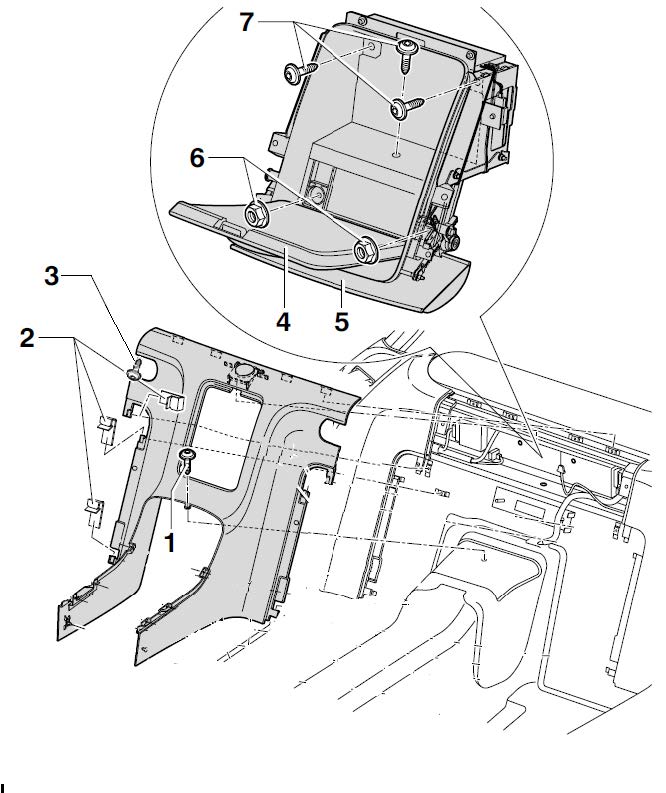
- Install the rear wall compartment, passenger side rear wall trim and the centre console armrest
- End of procedure
Warranty information:
| Operation | Defect Code | Repair Code | Time |
|---|---|---|---|
| Tank control unit replacement | BUGVR5/1 | 1 hr |
Chronology :
At the end of 2009 a car ran out of fuel during the final test drive in production – indicated 30 ltrs.
In January 2010 analysis has been conducted and concluded.
In February 2010 the repair solution has been published internally.
This has also been experienced in the field
7 Affected Products
Vehicles
15 Associated Documents
Recall Acknowledgement
 Loading...
Loading...
Remedy Instructions and TSB
RCRIT-16V200-6935.pdf 767.612KB
 Loading...
Loading...
Part 577 Owner Notification Envelope
 Loading...
Loading...
Defect 573 Report
RCLRPT-16V200-6022.PDF 30.42KB
 Loading...
Loading...
Recall 573 Report – Amendment 2
RCLRPT-16V200-2264.PDF 30.471KB
 Loading...
Loading...
Recall Quarterly Report #1, 2016-2
RCLQRT-16V200-4813.PDF 214.494KB
 Loading...
Loading...
Recall Quarterly Report #2, 2016-3
RCLQRT-16V200-1642.PDF 214.59KB
 Loading...
Loading...
Recall Quarterly Report #5, 2017-2
RCLQRT-16V200-5003.PDF 214.885KB
 Loading...
Loading...
Recall Quarterly Report #3, 2016-4
RCLQRT-16V200-1816.PDF 214.685KB
 Loading...
Loading...
Recall Quarterly Report #7, 2017-4
RCLQRT-16V200-4298.PDF 215.043KB
 Loading...
Loading...
Recall Quarterly Report #6, 2017-3
RCLQRT-16V200-3183.PDF 214.964KB
 Loading...
Loading...
Recall Quarterly Report #8, 2018-1
RCLQRT-16V200-7058.PDF 215.115KB
 Loading...
Loading...
Recall Quarterly Report #11, 2018-4
RCLQRT-16V200-9886.PDF 211.981KB
 Loading...
Loading...
Recall Quarterly Report #9, 2018-2
RCLQRT-16V200-6592.PDF 215.192KB
 Loading...
Loading...
Recall Quarterly Report #10, 2018-3
RCLQRT-16V200-6944.PDF 215.273KB
 Loading...
Loading...
Latest Recalls Documents
- The world’s #1 fuel additive for both gasoline and diesel engines
- A great tune-up in a bottle – treats gasoline, diesel fuel and increases MPG
- Cleans and lubricates the fuel system, including fuel injectors, carburetor and combustion chamber
- Improves fuel economy by burning excess exhaust emissions
- Increases power and acceleration by improving fuel flow and reducing deposit buildup
- Restores fuel economy
- Stabilizes ethanol
- Maximizes horsepower
- Improves responsiveness
- For use in both gasoline and diesel engines
- Specially formulated to remove carbon deposits from engines with over 75,000 miles
- Cleans fuel injectors, intake valves, and ports to restore performance and fuel economy
- Prevents future carbon build-up and reduces emissions
- Oxygen sensor safe and safe for use in turbocharged and supercharged vehicles
- Will not void OEM/manufacturer's warranty
- Cleans, restores, protects the entire fuel system (fuel injectors, carburetors, intake valves and combustion chambers)
- Restores: lost power, acceleration, lost fuel economy, and operation of the fuel gauge sensor
- Reduces: rough idle, engine surge, hesitation, and spark plug fouling
- Improves: cold start performance, and fuel stability for up to one year
- Automobiles and trucks use every 3,000 miles or at your next oil change. All other gasoline engines use as needed (motorcycles, dirt bikes, boats, ATVs, RVs, water craft, lawn care, etc.)
- Save gas by keeping fuel intake system clean
- Helps restore performance
- Removes deposits from entire fuel system
- Helps inhibit corrosion
- Compatible with cap-less fuel tanks
- Contains 100% High-Energy Solvent Technology
- Helps Keep Injectors Or Carb(S) And Intake Ports And Valves Clean
- Quickly Disperses Moisture And Dissolves Gum, Varnish, And Other Fuel Residues
- Disperses Moisture In Conventional Gasoline
- Eliminates starting problems, hesitation and stalling.Fit Type: Universal
- Smoother idling
- Better throttle response
- Cleaner combustion
- Upgraded Universal Fuel Injector Tester and Cleaner Tool Kit---Operates injectors individually to diagnose fuel delivery problems on petrol vehicles with electronic fuel injection, such as blockage, leakage, damage, and burnout of the injectors. The included 8-size cleaning adapters combined with the tester pulse mode can quickly clean the injectors
- 【Test for 2 Injectors Simultaneously & Ultra-long Power Cord】Come with two pairs of output terminals, allowing you to test for two injectors or for one injector at once. The tester power cord is up to 40inch and the test lead is up to 20 inches for convenient testing. The wires are made of superior silica gel, allowing the tester to work at high and low temperatures. (To make it perform better, it is recommended to work at normal temperatures.)
- 【8 Size Adapters Cleaning Tool & Universal Fit】Our cleaner small and large size adapters are compatible with most 12V EFI and GDI vehicle models' injectors. We also offer two additional specialized adapters for the BMW Audi, one is suitable for models such as V.W, Audi, etc. and another one with threaded hole is exclusively for BMW N series such as N14/N18/N20/N26/N53/N54/N55/N63/S63.
- 【8 Pulse Modes & LCD Display】The fuel injector tester kit is designed with 8 pulse modes, which are composed of 4 pulse signal output modes and 2 output voltage levels: Short/ Medium/ Long/ Continuous pulse modes + High/Low(12V/5V) power drive modes. This tester has a wide variety of pulse modes, providing a large testing space to accurately and quickly diagnose and repair petrol vehicle injectors' fuel delivery problems. The LCD displays the mode you are in.
- 【Polarity Reverse Connection Protection & Short Circuit Protection】Deigned with power input reverse connection protection and output short circuit protection function. In the case damaged or a short circuit of the pulse output terminal, the power indicator light of the fuel injector cleaner tool kit will flash to prompt you.
- Revitalize Your Engine: Gumout Multi-System Tune-Up is your ultimate fuel treatment gasoline solution, effortlessly cleaning GDI injectors, carburetors, and more for peak performance and fuel economy.
- Ultimate Engine Protection: Our advanced carburetor cleaner fuel additive prevents future carbon buildup, ensuring your engine runs smoothly. Perfect for gas, diesel, or ethanol engines, from cars to lawn mowers.
- Comprehensive Care: As a powerful fuel tank cleaner, Gumout cleans and conditions fuel systems, fighting ethanol and water corrosion while stabilizing fuel to reduce emissions and maximize engine life.
- Versatile Application: Add this gas treatment for car engines directly to the gas tank, crankcase, or via induction. Whether you're cleaning a carburetor or stabilizing gas, Gumout Multi-System Tune-Up has you covered.
SEOCONTENT-START
Technical Bulletin 16‐04‐013BUG Tank Control Unit April 2016 Page 1 of 6 Revision 1 Applicability: Bugatti Veyron Bugatti Grand Sport VIN range : Contact your Bugatti regional service manager Market Region: All Introduction: Fuel tank control unit requires replacement with later version. Description: Fuel tank indicator can show a higher fuel level than the actual level of fuel in the tank. A new control unit with revised software has been introduced to supply the correct signals from the level sensors. Warning: Comply with the vehicle preparation measures for maintenance and repair procedures. Refer to the official Workshop Manual, Page 18 “General instructions about the vehicle” If in any doubt regarding this procedure, contact your Bugatti regional service manager. Technical Bulletin 16‐04‐013BUG Tank Control Unit April 2016 Page 2 of 6 Revision 1 Procedure: 1. Remove centre console armrest (1) 2. Remove the passenger side rear wall trim Loosen the lower passenger rear wall trim ‐1‐ using a dismounting wedge (e.g. ‐3409‐), in direction of travel ‐arrows‐. Pull the lower rear wall trim‐2‐ in direction of travel –arrows to loosen the trim elements. Remove the trim ‐1‐ and ‐2‐ upwards in direction of arrow A‐. Technical Bulletin 16‐04‐013BUG Tank Control Unit April 2016 Page 3 of 6 Revision 1 3. Remove rear wall compartments (1) Open the flap for the tray with the button on the rear wall. Unclip the floor compartments ‐2‐ from the tray with a dismounting wedge Pull the rear wall compartments ‐1‐ out of the tray. 4. Centre rear wall trim loosing Use a dismounting wedge (e.g. ‐3409‐) to lever out the retaining clips ‐2‐. Open the cover ‐4‐ of the tray ‐5‐. Unscrew the fastening bolts ‐7‐ and fastening nuts ‐6‐ in the tray ‐5‐. Unscrew the fastening bolts ‐3‐ in the centre wall trim Unscrew the fastening bolts ‐1‐ in the monocoque Technical Bulletin 16‐04‐013BUG Tank Control Unit April 2016 Page 4 of 6 Revision 1 5. Gently pull the passenger side of centre rear wall to access the Tank control unit and unplug it. 6. Unscrew the 2 nuts with 10mm socket Passenger side view of the monocoque without interior trim Tank Control Unit Passenger side view of the Tank Control Unit (while pulling centre rear wall) Technical Bulletin 16‐04‐013BUG Tank Control Unit April 2016 Page 5 of 6 Revision 1 7. Remove the Tank Control Unit 8. Install the new Tank control Unit 5B0906020 B (Software version V 3.03) and screw the 2 nuts carefully (approx. 1Nm) 9. Connect the new Tank Control Unit 10. Install the centre rear wall trim Installation is in reverse order of removal. Tighten fastening Bolts ‐7‐ to 4,5Nm tightening torque Tighten mounting nuts ‐6‐ to 3 Nm tightening torque Tighten fastening Bolts ‐1‐ to 1 Nm tightening torque Tighten the retaining clips and check for firm seat (All clips must be replaced) Tighten fastening Bolts ‐3‐ to 1 Nm tightening torque 11. Install the rear wall compartment, passenger side rear wall trim and the centre console armrest Installation is in reverse order of removal 12. End of procedure Technical Bulletin 16‐04‐013BUG Tank Control Unit April 2016 Page 6 of 6 Revision 1 Warranty information: Operation Defect Code Repair Code Time Tank control unit replacement BUGVR5/1 1 hr Bugatti Bulletins are intended for use by experienced and trained technicians. If you lack the skills, tools, equipment and a suitable workshop for any procedure described in this document, we suggest you leave such repairs to an Authorised Bugatti Partner. See your Bugatti Partner for advice on whether your vehicle may benefit from the information contained within this document. The information contained in this Bulletin is accurate at the date of publication. However, Bugatti Automobiles S.A.S. regularly updates technical information. Please check with your Bugatti Partner that the Bulletin you intend to use contains the latest available information. Bugatti Automobiles S.A.S. All Rights Reserved
**************************************************************************************************************
OMB Control No.: 2127-0004 Part 573 Safety Recall Report 16V-200 The information contained in this report was submitted pursuant to 49 CFR §573 Manufacturer Name : Bugatti Submission Date : APR 07, 2016 NHTSA Recall No. : 16V-200 Manufacturer Recall No. : NR Manufacturer Information : Manufacturer Name : Bugatti Address : 1 Chateau St Jean Dorlisheim, France 00 67120 Company phone : 999 Number of potentially involved : 72 Population : Estimated percentage with defect : 100 Vehicle Information : Vehicle : 2006-2010 Bugatti Veyron Vehicle Type : LIGHT VEHICLES Body Style : 2-DOOR Power Train : GAS Descriptive Information : Fuel tank indicator can show a higher fuel level than actual level Production Dates : OCT 03, 2006 – JAN 17, 2010 VIN (Vehicle Identification Number) Range Begin : VF9SA15B36M795001 End : VF9SC2C27AM795238 ✔ Not sequential VINs Vehicle : 2010-2011 Bugatti Veyron Grand Sport Vehicle Type : LIGHT VEHICLES Body Style : 2-DOOR Power Train : GAS Descriptive Information : Fuel tank indicator can show a higher fuel level than actual level Production Dates : SEP 29, 2009 – JUN 30, 2010 VIN (Vehicle Identification Number) Range Begin : VF9SK2C27AM795002 End : VF9SK2C28AM795302 ✔ Not sequential VINs Description of Defect : Description of the Defect : Fuel tank indicator can show a higher fuel level than actual level FMVSS 1 :NR FMVSS 2 :NR Description of the Safety Risk : Potential for customer to run out of fuel and the car to stop, causing a risk of an accident Part 573 Safety Recall Report 16V-200 Page 2 The information contained in this report was submitted pursuant to 49 CFR §573 Description of the Cause : System tolerances lead to wrong signal to the indicator. Sensor interprets the signal incorrectly. Identification of Any Warning that can Occur : Engine will start to run rough and then stop Supplier Identification : Component Manufacturer Name : Bugatti Address : 1, Chateau St Jean Molsheim FOREIGN STATES 67120 Country : France Chronology : At the end of 2009 a car ran out of fuel during the final test drive in production – indicated 30 ltrs. In January 2010 analysis has been conducted and concluded. In February 2010 the repair solution has been published internally. This has also been experienced in the field Description of Remedy : Description of Remedy Program : On affected vehicles the fuel tank control unit will be replaced (combination of hardware and software improvement). Official Bugatti Partners to do the work. Bugatti will cover all the costs involved for the repair (no time or Km limit) How Remedy Component Differs from Recalled Component : The new control unit including software with a new part number has the fix to avoid wrong sensor signal. The right fuel level is given to the indicator. Identify How/When Recall Condition was Corrected in Production : The new tank control unit (combination of hardware and software improvement) introduced in February 2010. Recall Schedule : Description of Recall Schedule : Customers will receive a letter. Our Flying Doctors will also inform customers individually by phone/then e-mail to arrange an appointment to have the vehicles fixed. All but 5 cars have already been remedied. Planned Dealer Notification Date : NR – NR Planned Owner Notification Date :NR – NR Part 573 Safety Recall Report 16V-200 Page 3 The information contained in this report was submitted pursuant to 49 CFR §573 * NR – Not Reported
**************************************************************************************************************
OMB Control No.: 2127-0004 Part 573 Safety Recall Report 16V-200 The information contained in this report was submitted pursuant to 49 CFR §573 Manufacturer Name : Bugatti Submission Date : APR 13, 2016 NHTSA Recall No. : 16V-200 Manufacturer Recall No. : NR Manufacturer Information : Manufacturer Name : Bugatti Address : 1 Chateau St Jean Dorlisheim, France 00 67120 Company phone : 999 Number of potentially involved : 72 Population : Estimated percentage with defect : 100 Vehicle Information : Vehicle : 2010-2011 Bugatti Veyron Grand Sport Vehicle Type : LIGHT VEHICLES Body Style : 2-DOOR Power Train : GAS Descriptive Information : Fuel tank indicator can show a higher fuel level than actual level Production Dates : SEP 29, 2009 – JUN 30, 2010 VIN (Vehicle Identification Number) Range Begin : VF9SK2C27AM795002 End : VF9SK2C28AM795302 ✔ Not sequential VINs Vehicle : 2006-2010 Bugatti Veyron Vehicle Type : LIGHT VEHICLES Body Style : 2-DOOR Power Train : GAS Descriptive Information : Fuel tank indicator can show a higher fuel level than actual level Production Dates : MAR 10, 2006 – JAN 17, 2010 VIN (Vehicle Identification Number) Range Begin : VF9SA15B36M795001 End : VF9SC2C27AM795238 ✔ Not sequential VINs Description of Defect : Description of the Defect : Fuel tank indicator can show a higher fuel level than actual level FMVSS 1 :NR FMVSS 2 :NR Description of the Safety Risk : Potential for customer to run out of fuel and the car to stop, causing a risk of an accident Part 573 Safety Recall Report 16V-200 Page 2 The information contained in this report was submitted pursuant to 49 CFR §573 Description of the Cause : System tolerances lead to wrong signal to the indicator. Sensor interprets the signal incorrectly. Identification of Any Warning that can Occur : Engine will start to run rough and then stop Supplier Identification : Component Manufacturer Name : Bugatti Address : 1, Chateau St Jean Molsheim FOREIGN STATES 67120 Country : France Chronology : At the end of 2009 a car ran out of fuel during the final test drive in production – indicated 30 ltrs. In January 2010 analysis has been conducted and concluded. In February 2010 the repair solution has been published internally. This has also been experienced in the field Description of Remedy : Description of Remedy Program : On affected vehicles the fuel tank control unit will be replaced (combination of hardware and software improvement). Official Bugatti Partners to do the work. Bugatti will cover all the costs involved for the repair (no time or Km limit) How Remedy Component Differs from Recalled Component : The new control unit including software with a new part number has the fix to avoid wrong sensor signal. The right fuel level is given to the indicator. Identify How/When Recall Condition was Corrected in Production : The new tank control unit (combination of hardware and software improvement) introduced in February 2010. Recall Schedule : Description of Recall Schedule : Customers will receive a letter. Our Flying Doctors will also inform customers individually by phone/then e-mail to arrange an appointment to have the vehicles fixed. Owners may contact their dedicated Flying doctor or Bugatti on tel.(805) 557-1050” All but 5 cars have already been remedied. Planned Dealer Notification Date : APR 14, 2016 – APR 15, 2016 Planned Owner Notification Date : APR 22, 2016 – APR 22, 2016 Part 573 Safety Recall Report 16V-200 Page 3 The information contained in this report was submitted pursuant to 49 CFR §573 * NR – Not Reported
**************************************************************************************************************
SEOCONTENT-END
Last update on 2025-04-17 / Affiliate links / Images from Amazon Product Advertising API
This product presentation was made with AAWP plugin.

